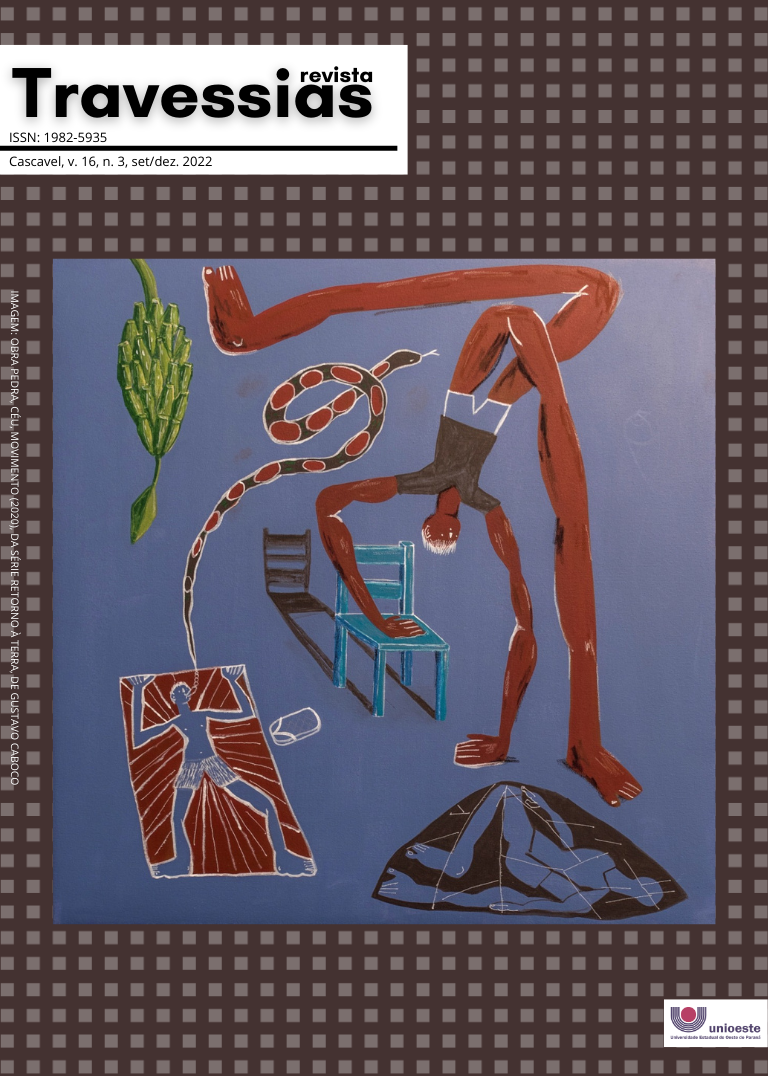Que corpo é esse?
A construção dos corpos femininos na narrativa de Sheyla Smanioto
DOI:
https://doi.org/10.48075/rt.v16i3.29924Palavras-chave:
corpo feminino, tipologia do corpo, Elódia Xavier, DesesterroResumo
Nas últimas décadas, o corpo feminino tem sido ressignificado enquanto categoria analítica e compreendido em sua concretude sócio-histórica, não mais resumido em sua condição meramente biológica. Partindo deste pressuposto, o objetivo do presente artigo é analisar de que forma o corpo feminino é representado na literatura contemporânea de autoria feminina. Para alcançar este objetivo, orientamo-nos através dos fundamentamos da tipologia da representação do corpo nos textos literários escritos por mulheres, construída por Elódia Xavier, renomada estudiosa da área de literatura brasileira e feminina, no livro intitulado Que corpo é esse? O corpo no imaginário feminino (2021) — cujo título da presente pesquisa faz uma referência direta. A obra selecionada como corpus para a análise foi o premiado romance de estreia da autora contemporânea Sheyla Smanioto, Desesterro (2015), o qual narra a dura realidade de quatro gerações de mulheres do sertão nordestino, constantemente submetidas a variadas manifestações de violência. Os resultados alcançados apontam para a multiplicidade das representações das personagens femininas smaniotianas, as quais podem enquadrar-se em diferentes categorias corpóreas elencadas por Elódia Xavier. Sheyla Smanioto nos apresenta personagens que são fruto da violência com o intuito de denunciar e problematizar a naturalização de estruturas de dominação, além de evidenciar que existem outros caminhos e possibilidades para o corpo feminino.
Downloads
Referências
DALCASTAGNÈ, Regina. A personagem do romance brasileiro contemporâneo: 1990-2004. Estudos de Literatura Brasileira Contemporânea. Brasília, n. 26, p. 13-71, 2005.
DOLL, Karine Mathias. Sobre mulheres subterrâneas e exumação narrativa: uma leitura de Desesterro (2015), de Sheyla Smanioto. Eixo Roda. Belo Horizonte, v. 29, n. 3, p. 208-226, 2020.
HOOKS, bell. Erguer a voz: pensar como feminista, pensar como negra. Tradução de Cátia Bocaiuva Maringolo. São Paulo: Elefante, 2019.
IBGE — INSTITUTO BRASILEIRO DE GEOGRAFIA E ESTATÍSTICA. Pesquisa Nacional por Amostra de Domicílios Contínua 2019. Rio de Janeiro: IBGE, 2020.
KLUMB, Stefani Andersson. Mulheres marcadas: a ficcionalização da violência contra a mulher na literatura brasileira. 2021. 109 páginas. Trabalho de Conclusão de Curso de Letras — Espanhol e Português como Línguas Estrangeiras — Universidade Federal da Integração Latino-Americana, Foz do Iguaçu, 2021.
LUGONES, María. Colonialidade e gênero. In: HOLLANDA, Heloisa Buarque de. Pensamentos feministas hoje: perspectivas decoloniais. Tradução de Pê Moreira, Bárbara Martins, Bruna Mendes, Cristine Carvalho, Igor Ojeda, Juliana Araújo e Juliana Luz. Rio de Janeiro: Bazar do Tempo, 2020, p. 53-83.
PEREIRA, Maria do Rosário Alves. Que corpo é esse na literatura contemporânea escrita por mulheres? Revista Fórum Identidades. Itabaiana-SE, Universidade Federal de Sergipe, v. 33, nº 1, p. 87-100, 2021.
SMANIOTO, Sheyla. Desesterro. Rio de Janeiro: Record, 2018.
SPIVAK, Gayatri Chakravorty. Pode o subalterno falar? Tradução de Sandra Regina Goulart Almeida, Marcos Pereira Feitosa e André Pereira Feitosa. Belo Horizonte: Editora UFMG, 2010.
XAVIER, Elódia. Que corpo é esse? O corpo no imaginário feminino. Rio de Janeiro: Oficina Raquel, 2021.
Downloads
Publicado
Como Citar
Edição
Seção
Licença
Copyright (c) 2022 Autores mantêm os direitos autorais e concedem à revista o direito de primeira publicação, com o trabalho simultaneamente licenciado sob CC-BY-NC-SA 4.0 que permite o compartilhamento do trabalho com indicação da autoria e publicação inicial nesta revista

Este trabalho está licenciado sob uma licença Creative Commons Attribution-NonCommercial-ShareAlike 4.0 International License.
Aviso de Direito Autoral Creative Commons
Política para Periódicos de Acesso Livre
Autores que publicam nesta revista concordam com os seguintes termos:
1. Autores mantêm os direitos autorais e concedem à revista o direito de primeira publicação, com o trabalho simultaneamente licenciado sob a Licença Creative Commons Attribution que permite o compartilhamento do trabalho com reconhecimento da autoria e publicação inicial nesta revista.
2. Autores têm autorização para assumir contratos adicionais separadamente, para distribuição não-exclusiva da versão do trabalho publicada nesta revista (ex.: publicar em repositório institucional ou como capítulo de livro), com reconhecimento de autoria e publicação inicial nesta revista.
3. Autores têm permissão e são estimulados a publicar e distribuir seu trabalho online (ex.: em repositórios institucionais ou na sua página pessoal) a qualquer ponto antes ou durante o processo editorial, já que isso pode gerar alterações produtivas, bem como aumentar o impacto e a citação do trabalho publicado (Veja O Efeito do Acesso Livre).
Licença Creative Commons
Esta obra está licenciada com uma Licença Creative Commons Atribuição-NãoComercial-CompartilhaIgual 4.0 Internacional, o que permite compartilhar, copiar, distribuir, exibir, reproduzir, a totalidade ou partes desde que não tenha objetivo comercial e sejam citados os autores e a fonte.



